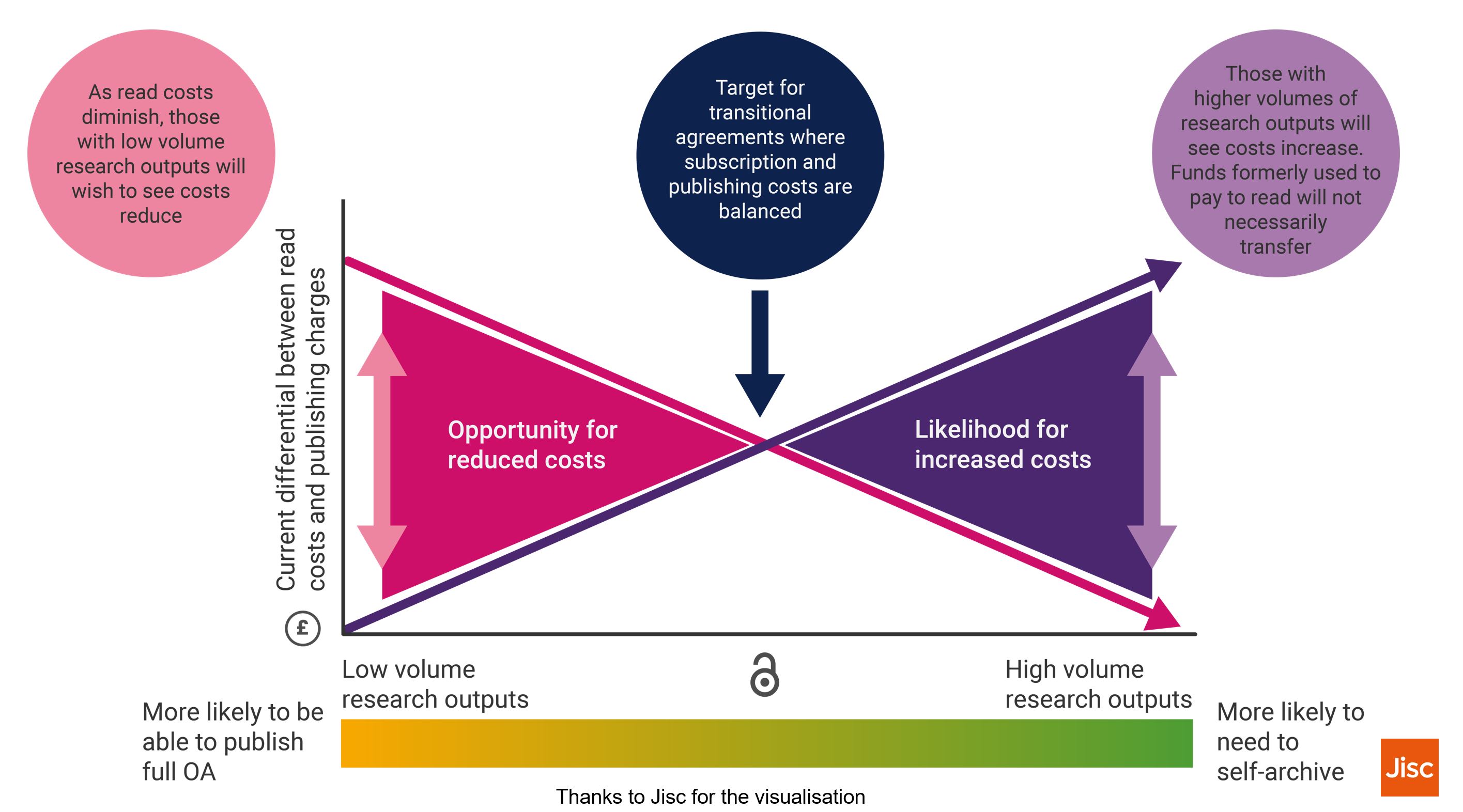Response to Guidance on the Implementation of Plan S from the
UKSCL Model Institutional Open Access Policy community
A PDF of the response can be downloaded here
Background
The UKSCL community comprise a number of UK HE institutional libraries[1] who have been working since 2015 on a model Institutional Open Access Policy to support academics seeking to make their work open access, to comply with funder OA policies and to ensure eligibility for the Research Excellence Framework.[2] We believe our Model Institutional Open Access Policy and the benefits it can provide in helping cOAlition S meet its objectives more effectively.
The UKSCL community welcomes the move to align funder Open Access Policies. It also recognises that research and publication are global and collaborative ventures and that collaborators do not all have equal access to research funding, nor are most of them covered by funders with open access policies and aims.
In feeding back to cOAlition S separately from our institutions, UK-SCL is seeking to share our experience following our proposals to roll out a “one size fits all” Model Institutional Open Access Policy in the UK, in the hope that the information might help inform cOAlition S’s next steps with Plan S.
Feedback Summary
The global context: cOAlition S funded research as a percentage of global scholarly output
Whilst the UKSCL community supports a general move to open access to the research findings of academics at its institutions, the overall context must be taken into account:
At present, it is estimated that cOAlition S signatory funded research results in the production of less than 8% global published outputs arising from research and that wholesale changes of publisher business model are likely only once that funder base increases substantially. In the meantime, it seems inevitable that a mixed model will need to continue to exist.
Main challenges with Plan S
The Implementation Guidelines as they currently stand present issues which have the potential to reverse inadvertently the trend towards greater OA in the UK. This is because they would:
- Result in an increased financial burden for research intensive institutions, including at worst perpetuating the subscription model
- Limit funding available for exploring new publishing business models, particularly models which would support learned societies in a sustainable transition to OA publishing of their journals.
- Risk alienating a community already deeply engaged in open science practices, some of whom have been at the vanguard of open access for over 20 years, including open access publishing.
Aims of this feedback: seeking clarification and suggesting further actions
This Feedback is both aimed at eliciting clarification and at suggesting further actions that might be considered by cOAlition S funders. We believe these actions would afford an opportunity for practical, achievable and affordable steps to be taken towards accelerating Plan S aims of making full and immediate open access a reality. In summary, these include:
- Seeking an achievable implementation period, one which is scalable along with the growth in number of cOAlition S signatories and therefore the percentage global research outputs covered by those funders and their open access policies;
- Seeking clarification on the intentions around transformative publishing agreements and suggesting an approach that will not adversely impede choices of cOAlition S funded authors at a time when c. 92% of their counterparts may not be covered by such policies;
- Seeking clarification on the “unit” of the transformational agreements – Journal or Publisher? In making this response we note that content is typically negotiated at publisher level, rarely at the level of the individual journal;
- Highlighting the role of our community’s Model Institutional Open Access Policy as a mechanism for achieving Plan S aims. We believe it can act as a lever to constrain costs and as a mechanism to ensure retention of choice of venue of publication. This can be achieved while membership of cOAlition S grows and while institution/consortial negotiations with publishers are ongoing;
- Seeking clarification of and changes to the repository deposit criteria to enable researchers to continue to harness the rich network of existing repositories available to them. In the UK at least, that we believe that no institutional repositories yet meet the Plan S repository criteria, that repositories are integrated with institutional current research information systems and that change in this systems infrastructure is highly unlikely to be prioritised until the conclusion of the 2021 Research Excellence Framework exercise.
- Noting effort needed to support learned societies in their re-thinking of business models to comply with Plan S whilst still remaining financially viable.
As requested, our detailed feedback is now given under the headings you provided:
1. Is there anything unclear or are there any issues that have not been addressed by the guidance document?
Transformative AGREEMENTS: by publisher or by journal?
It is essential that we seek clarification as to how Plan S interprets journals covered by transformative agreements[3] and that we analyse and communicate the consequences arising from that clarification. A discussion with one cOAlition S signatory raised alarm bells because they were talking about journals, not about publishers. In stating taking this position, they drew attention to Section 2 of the Guidance on the implementation of Plan S which includes the following two statements:
- Authors publish in a Plan S compliant Open Access journal
- Authors publish Open Access with a CC BY licence in a subscription journal that is covered by a transformative agreement that has a clear and time-specified commitment to a full Open Access transition
To understand the implications of these guidelines, it is important to understand how content is licensed, how current and emerging transformative deals work, and to recognise that universities, often as part of wider consortia, mostly subscribe to publishers (Bundled Deals) and not to individual journals. If Plan S really means journals, then we anticipate considerable challenges, challenges which essentially set Plan S up to fail unless an exceptional set of circumstances come into alignment within the very short transition timeline indicated.
Publishers:
- Libraries subscribe to bundles of content – typically via a publisher
- Read and Publish (R&P) deals are negotiated at the publisher level, not at the journal level, but they do ensure that over time, 100% of the outputs by academics at institutions taking the R&P Deal can be published OA in journals covered by that publisher R&P deal
- cOAlition S currently funds <8% of global research outputs so, even if there were 100% compliance via R&P publisher deals negotiated by institutions, the remaining ~92% of outputs in those journal bundles would still not be covered.
- If all institutions covered by cOAlition S funders negotiate R&P deals with all publishers with whom their academics publish, then 100% of cOAlition S funded work published in journals published by those publishers is OA (i.e. whatever percentage of the <8% global publishing that those publishers represent). However, it is highly unlikely that individual journals published by that publisher will be OA under this scenario because most journals will attract few or no articles from cOAlition S funded research.
Journals
- For any given large publisher portfolio of journals, the cohort of journals in which academics publish will change and evolve over time. Whilst an academic may still publish in a Publisher X journal, it may not always be the same Publisher X journal. Also, journals may move publisher.
- This gradual evolution of publishing choice, combined with the <8% funding coverage create a challenge for publishers if cOAlition S is evaluating success at the journal level (as was understood from the cOAlition S funder discussion): the likelihood of a publisher flipping each and every journal in which an academic ‘covered by cOAlition S funding’ publishes is very remote – certainly whilst the percentage publishing covered by those funders remains as low as it is currently.
- Analysis shows that there is a very long tail of journals with single digit article publishing in any one year from cOAlition S funders. This tail is long and includes many society journals where the society has outsourced its publishing activities to one of the large commercial publishers. Unless a journal is publishing solely cOAlition S funded work or is publishing a growing percentage of cOAlition S funded research, it will almost certainly not be in position to flip completely to OA. Bold societies who have attempted to flip popular journals have seen a dramatic decline in submissions, in part attributed to the ability of the author to pay to publish.
- If cOAlition S means journal rather than publisher, our reading is that all the following conditions would have to be met for Plan S to succeed:
- cOAlition S successfully bring on board all other significant funders of research
- All publishers of cOAlition S funded outputs offer an affordable R&P deal to all institutions covered by cOAlition S funders
- All institutions covered by cOAlition S funders take the deal.
If, however, we are talking about publishers, then, under the publisher scenario above, it would be possible for all academics outputs at cOAlition S funded institutions to meet Plan S aims, provided that the deal is affordable to institutions and as long as it scales to 100% of that institution’s publishing over time.
Additional attributes of a transformative agreement that might be considered by Plan S
- Machine readable licences to facilitate the flow of data and the automation of some text and data mining activities which can legitimately be performed on OA content.
- Where a publisher is not yet in a position to offer a transformative deal, or to flip their journals to Open Access, the publisher offered either
- a Plan S compliant ‘self-archiving’ route, or
- an undertaking not to refuse to publish work from an author solely on the grounds that the author belongs to an institution which has adopted a Plan S-compliant Model Institutional Open Access Policy, like our community’s one, whereby rights are retained on behalf of academics and Author Accepted Manuscripts can be self-archived in line with cOAlition S aims.
Timescale
Clarity about which entity (journal or publisher) any cOAlition S funder policy applies, and from which date, are key factors in ensuring that Plan S aims are achievable. Publisher negotiations can sometimes take two or more years to reach a conclusion and negotiations are generally staggered so as to be manageable by institutions and consortia negotiators. Learned Societies do not yet necessarily have alternative publishing service providers to turn to, and the length of time from a decision to ‘consider a move of provider’ to ‘first publishing with a new provider’ can be three years or more. We recommend that the guidelines recognise these timelines noting that these will be directly influenced by the pace at which the cOAlition S group grows.
Open Access Repositories & the role of a Model Institutional Open Access Policy
As written, the guidance appears to require publishers to undertake/facilitate the work of repository deposit and the repository criteria appear to have been drawn up with this in mind.
However, we envisage a scenario, particularly in the early years of Plan S implementation, whereby our community’s Model Institutional Open Access Policy, incorporating rights retention and Plan S compliant licensing and embargo periods, will be needed in addition to publisher negotiations for transformative publisher deals, particularly in the event that those deals proving to be unaffordable.
That being the case, author self-archiving will most likely be the means by which Author Accepted Manuscripts (AAM) will be deposited and made available through repositories. To this end, it would be helpful if the current repository infrastructure were also considered as a valid and valuable mechanism to meet Plan S aims.
With the above in mind, we support the COAR response[4] to the Plan S repository requirement statement.
To set this in context: at UKSCL community institutions we have already experienced strong publisher pushback on proposals to roll out adoption of the UKSCL Model Institutional Open Access Policy. Rather than contributing to the perpetuation of the status quo for subscribed content, it is our belief that widespread adoption of our Model Institutional Open Access Policy which meets Plan S requirements will provide a further legal lever to encourage publishers to develop their own affordable and transformative routes towards achieving Plan S aims and to demonstrate the value that they otherwise add to the scholarly communications process beyond the availability of the AAM text in a repository.
The Policy, based on the “Harvard model OA policy”[5], enables the automatic retention of rights by the institution, rights which individual academics at that institution can choose to exercise in full or in part.
The work undertaken in the UK has achieved a policy which works in the context of UK Copyright legislation. It’s development has been supported by expert IP legal advice.
The work was originally prompted as a result of the “policy stack”[6] situation in the UK: multiple funder OA policies with differing compliance criteria coupled with multiple publisher policies, some of which varied according to the funding received by the authoring academics. However, we also believe that the Model Institutional Open Access Policy has a potentially significant role to play in the realisation of cOAlition S aims of “making full and open access a reality”.[7]
The UKSCL Model Institutional Policy is fundamentally about rights retention and early release of the findings about research – all called for in Plan S. Despite the differing copyright regimes in the USA and the UK, we have been able to draw up a policy which works legally within UK copyright legislation.
It is important to understand how the UKSCL Model Institutional Open Access Policy works in practice as there are three components:
- Where an institution has adopted the UK-SCL as its model OA policy, rights retention on behalf of the academic come into existence at the point the Author Accepted Manuscript (AAM) comes into existence. Those rights are then transferred back to the academic. This step is essential – those steps that follow could then be made optional, particularly in the early days of Plan S funder policies.
- Licence choice on deposit: the current default UK-SCL licence is CC BY-NC in line with the minimum requirements for the current RCUK policy. It is our intention to align the licence with cOAlition S funder policies once those are clarified. However, particularly in the early days of want we envisage to be a new set of cOAlition S-aligned policies, institutions could choose to allow the academic to select a more restrictive licence on deposit. The academic will still, themselves, have the right at a future date to re-release the output on the more liberal licence retained on their behalf should they so wish.
- AAM availability through the repository: the UKSCL default is zero months after publication (earlier if publishers allow). Institutions could also allow academics to request a longer embargo, up to the maximum allowed by their research funders for those academics not funded by a funder with shorter embargo periods.
Academic responses to the UKSCL Model Institutional OA Policy: a dislike of a one-size-fits-all policy
Discussions between institutions, academics and with some publishers on which Creative Commons Licence to adopt for the UKSCL took over two years. Nonetheless, even once we had settled on a CC BY-NC licence we continued to experience significant pushback, particularly from the Arts, Humanities and Social Sciences communities who, for a variety of reasons that their own community responses to Plan S feedback will outline, remain adamant that a CC BY-NC-ND licence is their preferred choice at this time. In the early days of discussion the UKSCL acted as a lightning rod for opposition to all things OA, irrespective as to whether either OA in general or the UKSCL in particular were the cause of those issues.[8]
Our solution was a pragmatic one: to propose, as indicated above, that our institutions move to adopting the policy but offer the opportunity for academics at our institutions to choose more restrictive licence and availability terms. This solution has helped with the dialogue with academics and learned societies expressing concern for the liberal licence originally called for in the UKSCL.
The UKSCL community would urge cOAlition S also to consider that ‘one size may not fit all communities’ – a more liberal approach to licensing in the early period of Plan S OA policies would do much to allay the concerns of academics and would, we believe, give an opportunity to evaluate whether the concerns play out in reality.
Nevertheless, even if cOAlition S continues to insist on the more open license route, the UK-SCL ‘step 1’ concerning rights retention has the ability to ‘fast track’ Plan S compliance in terms of making material open access more swiftly via the repository route as explained in the next section.
2. Are there other mechanisms or requirements funders should consider to foster full and immediate Open Access of research outputs?
The role of an Model Institutional Open Access Policy which retains rights which achieve Plan S aims
We believe that institutional open access policies have a role to play in meeting Plan S aims:
- As a lever to constrain costs. Widespread deals which result in a “read and publish” service for universities/consortia are a relatively new development and cost constraint, affordability, value for money and global applicability remain unproven. At their worst, they run the risk of perpetuating the subscription model and of tying funding up with traditional publishing rather than releasing it to support new initiatives. Universities may need an alternative means of ensuring the outputs of their researchers are available open access. An Institutional Open Access Policy which achieves the rights retention, and availability envisioned by cOAlition S would fulfil this role, particularly if it enabled the release of funding to support alternative models of scholarly communication of research findings.
- cOAlition S support for an institutional rights-retention policy, such as ours, as a means of advancing cOAlition S funder aims would allay significant concerns amongst the research community that publishing choices may become overly restricted by circumstances beyond their control. If their journal of choice is unable to offer either a transformative deal to subscribing libraries, or a Plan S compliant self-archiving policy, then, if their institution has adopted our Model Institutional Open Access Policy, rights will have been retained on their behalf which enable them to meet Plan S aims through deposit in their institutional repository.
- The UKSCL community were already working with colleagues to align copyright and IP policies and we note that these will now need to be aligned with cOAlition S aims, including ensuring that retention of copyright is meaningful and is not undermined by an overly restrictive licence to publish that might be signed with a publisher.
3. Are there any issues around the feasibility of Plan S, e.g., known barriers, areas where there may need to be an exception?
The main barrier to the success of Plan S is the relatively low percentage of content covered by cOAlition S funders. For Plan S aims to become reality, significant effort needs to be devoted to expanding the list of signatories to cOAlition S, or to other groupings seeking similar aims to Plan S. To this end, we see the recent announcement that librarians and funders in China are seeking immediate access to funded research outputs as a significant move, but unless there are similar moves with US funders the tipping point will be hard to reach. We would urge greater effort to be expended on this market as much publisher global policy is driven from the US.
Prepared by Chris Banks on behalf of the UKSCL Community
chris.banks@imperial.ac.uk
@ChrisBanks
[1] Over one hundred UK HE institutions are represented on the UKSCL discussion list, along with a growing number of institutions from Europe and Australia.
[2] https://ukscl.ac.uk/
[3] Typically, these are deals negotiated at a publisher level. They are becoming known as “Read and publish” deals and over time they allow read access to all content from that publisher covered by the deal and allow an institution’s academics to publish open access in all journals covered by the deal.
[4] https://www.coar-repositories.org/files/COAR-response-to-implementation-of-Plan-S-February-6-2019.pdf
[5] https://osc.hul.harvard.edu/modelpolicy/
[6] https://insights.uksg.org/articles/10.1629/uksg.292/
[7] https://www.coalition-s.org/
[8] Issues included those of third party rights, moral rights and translation, none of which are caused nor solved by the UKSCL





